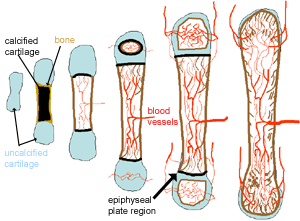Bone: Ossification
The formation of bone (ossification) occurs in one
of two ways:
- Intramembranous ossification - bone is formed by direct replacement of mesenchyme.
- Endochondral ossification - cartilage model serves as the precursor of bone.
Intramembranous and Endochondral ossification
Both of these forms of ossification are involved in producing most of the bones of the skeleton.
Intramembranous ossification
Use the eMicroscope on the left to examine this longitudinal section through a fetal foot. Find the longer (metatarsal) developing bone. About halfway along, you should see a thin layer of red staining bone matrix close to its surface. This is known as the periosteal cuff.
Make sure you can recognise the periosteal cuff, periosteum, cartilage and perichondrium.
The periosteal cuff is synthesised by connective tissue - i.e. there is no intermediate cartilage stage, but the bone is formed directly onto mesenchyme tissue. This type of ossification is therefore an example of intramembranous ossification.
Toggle labels
Endochondral ossification
Look again at the section above, in the centre of the diaphysis,
beneath the periosteal cuff, the cartilage is
being replaced by bone in a so-called primary centre of
ossification. At such sites the cartilage begins to undergo
hypertrophy and calcification, allowing the penetration of blood
vessels which bring with them the osteoblast and bone marrow precursors.
This is therefore an example of endochondral ossification.

In endochondral ossification:
- The bone is formed onto a temporary cartilage model.
- The cartilage model grows (zone of proliferation),
then chondrocytes mature (zone of maturation) and hypertropy (zone
of hypertrophy), and growing cartilage model starts to calcify.
- As this happens, the chondrocytes are far from
blood vessels, and are less able to gain nutrients etc, and the
chondrocytes start to die (zone of cartilage degeneration). The
fragmented calcified matrix left behind acts as structural framework
for bony material.
- Osteoprogenitor cells and
blood vessels from periosteum invade this area, proliferate and
differentiate into osteoblasts, which start to lay down bone matrix (osteogenic zone).
In the fetus, the primary ossification centre forms first in the
diaphysis. Later on a secondary ossification centre forms in the epiphyses.
Cartilage is replaced by bone in the epiphysis and diaphysis, except
in the epiphyseal plate region. Here the bone continues to grow,
until maturity (around 18 years old). The resulting bone is a thick
walled cylinder, that encloses a central bone marrow cavity.
Look at the eMicroscope section on the left to examine an epiphyseal growth plate.
Make sure you can identify articular cartilage, the epiphysis, the diaphysis, primary and secondary centres of ossification, and the epiphyseal (or growth) plate of cartilage lying between these centres of ossification.To help you recognise the zones in the growth plate, here is a diagram of the different zones, found in the growth plate.
Toggle labels
The cartilage is not converted to bone, but is gradually replaced by it. The osteoblasts and blood vessels invade the area of degenerating cartilage.
Find out for yourselves what is happening in each of these zones.
 What do you think the role of the epiphyseal plate is.
What do you think the role of the epiphyseal plate is.
 What will happen if it fails in this function?
What will happen if it fails in this function?
 This image may also be viewed with the Zoomify viewer.
This image may also be viewed with the Zoomify viewer.

This shows a diagram of the epiphyseal growth plate.

 What do you think the role of the epiphyseal plate is.
What do you think the role of the epiphyseal plate is.